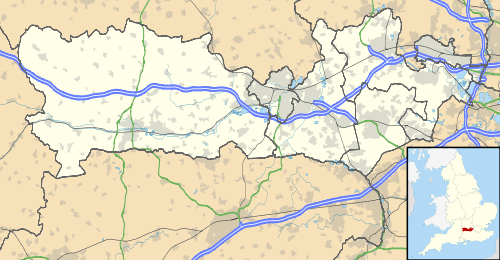Clewer
Clewer /ˈkluːər/ (also known as Clewer Village) is an ecclesiastical parish and an area of Windsor in the county of Berkshire, England.[1] Clewer makes up three wards of the Royal Borough of Windsor and Maidenhead, namely Clewer North, Clewer South and Clewer East.[2]
History

The name Clewer comes from the word Clifwara meaning "cliff-dwellers", and is named after those who lived below the hill on which Windsor Castle was built.[3] Historically, Clewer pre-dates New Windsor and still exists as a separate ecclesiastical parish. A Saxon settlement existed there, and it is thought that the settlement of Clewer may have grown up at a place where the river Thames could be forded. A wood-and-thatch Saxon church is believed to have existed on the site of the present church. The surviving font is thought to be Saxon, and is presumed to have belonged to the earlier church. Until the 1850s this font was in an improbable position at the west end of the north aisle and it is likely that it had never been moved from its position in the earlier Saxon church.
By the time of the Norman Conquest, there was a Manor of Clewer, mentioned in the Domesday Book as Clivore and recorded as having a church and mill. It was from here that William I took the lands on which he built his fort, which became Windsor Castle. The Manor of Clewer continued to receive a rent of 12 shillings per annum from the Crown for this land until the 16th century.[3] The present St Andrew's Church is of Norman construction[4] and it is traditionally believed that William I habitually attended mass there, as there was no chapel within the original castle. It has a 14th-century chantry chapel to the memory of the second wife of the hero of the Hundred Years' War, Sir Bernard Brocas. The family lived in the sub-manor of Clewer Brocas until rebellious activities obliged them to retreat[4] to obscurity at Beaurepaire in Sherborne St John.
The Clewer Park area of Clewer Village is where the former home of Sir Daniel Gooch once stood.[3]
It was at Clewer that Charles Thomas Wooldridge murdered his wife Laura Ellen; the execution of Wooldridge in 1896 was immortalised in Oscar Wilde's The Ballad of Reading Gaol.
Hatch Lane is the site of the former Community of St John Baptist convent which closed in 2001, when the community moved to Oxfordshire.[5]
Notable residents
- Sir Bernard Brocas, 14th-century English commander
- Sir Bernard Brocas Junior, early 15th-century rebel
- Sir Daniel Gooch, 19th-century railway engineer, lived at Clewer Park[3]
- Una Hawthorne, daughter of Nathaniel Hawthorne
- Natalie Imbruglia, singer, has lived on White Lilies Island for several years[3]
- Sir Michael Caine, actor and film producer
- Jimmy Page, guitarist
See also
References
- Ordnance Survey: Landranger map sheet 175 Reading & Windsor (Henley-on-Thames & Bracknell) (Map). Ordnance Survey. 2012. ISBN 9780319232149.
- "Ordnance Survey Election Maps". www.ordnancesurvey.co.uk. Ordnance Survey. Archived from the original on 20 February 2016. Retrieved 18 February 2016.
- "Clewer - Windsor, Berkshire". www.windsor-berkshire.co.uk. Retrieved 1 April 2016.
- P H Ditchfield; William Page, eds. (1923). 'Parishes: Clewer', in A History of the County of Berkshire: Volume 3. London: Victoria County History. pp. 72–77. Retrieved 18 March 2016.
- "The Community of St John the Baptist Hatch Lane, Windsor". The Royal Windsor website.
- Raymond South: The Book of Windsor, Barracuda Books, 1977, ISBN 0-86023-038-4
